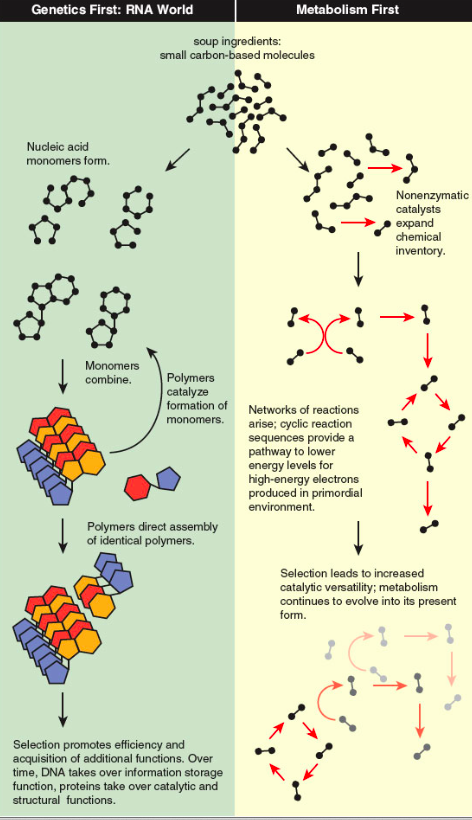
In class this week we learned about two possible explanations for the first left forms on Earth. The two different hypothesizes were Metabolism first and Replication first. We spilt up into groups and had half the group research metabolism first, and the other half research replication first and when we were done we presented out hypothesizes to the other half of our group and then researched facts to debunk the two hypothesizes.
Replication First:
In the replication first hypothesis it is said that some molecule, that was originally thought to be RNA but now other molecules are considered possibilities – was able to self-replicate. For example, we have known for more many years that certain RNA molecules, ribozymes, can catalyze biochemical reactions. An RNA replicase ribozyme would be an RNA molecule that could replicate itself. The energy used would come from the surroundings, not from the replicating system itself. As the replicators evolved, new functions would be picked up by the systems, including energy-utilizing ones. So replication comes first, then metabolism.
Metabolism First:
In metabolism first hypothesis, the first reactions involve spontaneous formation of simple molecules such as acetate, a two-carbon compound formed from carbon dioxide and water. Pathways leading to the synthesis of simple organic molecules might be promoted by natural catalysts such as minerals and porous surfaces in rocks. The point is that the origin of life is triggered by the accumulation of very simple organic molecules in thermodynamically favorable circumstances.
Simple organic molecules can then be combined in various ways that result in simple amino acids, lipids, etc. These could act as catalysts for the formation of more organic molecules and is the start of metabolism.
Evidence Against Replication first:
I support the hypothesis of metabolism first, mainly because there appear to be far more holes in the replication first hypothesis, such as:
- Even when RNA is properly assembled using all the same linkages, RNA is an unstable molecule.
-
RNA and the more stable DNA differ only at one atom: an oxygen atom on the ribose sugar. This small atom has big consequences for the structure and stability of the molecule. Notably, the oxygens in the RNA attack the bonds that form the scaffold of the RNA polymer, breaking the RNA into its constituent nucleotides.